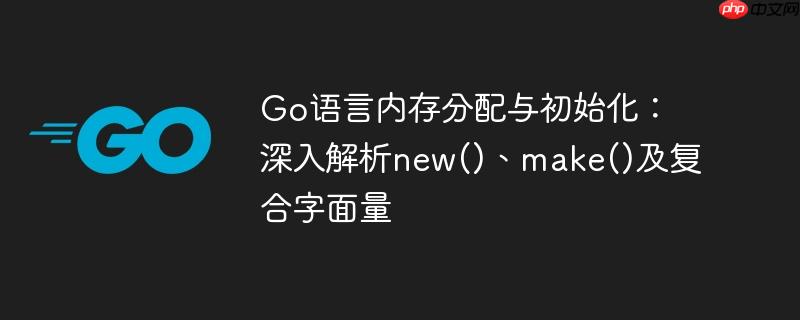
本文深入探讨go语言中内存分配与初始化的多种机制,包括new()、make()、复合字面量&T{}以及取址操作&localVar。文章将详细阐述new()和make()各自的独特用途、返回类型差异,并解释为何Go语言设计者选择保留这两个独立的内置函数,旨在帮助开发者清晰理解并正确选择适合的内存管理方式。
Go语言内存分配与初始化概览
在go语言中,创建并初始化变量或数据结构涉及到内存的分配。go提供了多种灵活的机制来完成这项任务,主要包括:
- 复合字面量(Composite Literals):如&T{…},用于结构体、数组、切片和映射的分配与初始化。
- 取址操作符(Address-of operator):如&someLocalVar,获取现有变量的内存地址。
- new() 内置函数:用于分配任意类型的内存,并将其初始化为零值,返回指向该内存的指针。
- make() 内置函数:专门用于分配并初始化切片(slice)、映射(map)和通道(channel)这三种内置引用类型。
理解这些机制的异同对于编写高效且正确的Go程序至关重要。
复合字面量与取址操作
复合字面量提供了一种简洁的方式来同时分配内存并初始化结构体、数组、切片或映射。当用于结构体时,它通常与取址操作符&结合使用,以返回一个指向新分配并初始化的结构体实例的指针。
示例:结构体分配与初始化
type Point struct { X, Y int } // 使用复合字面量分配并初始化一个Point结构体,返回*Point类型指针 p1 := &Point{2, 3} // 等价于先声明一个Point变量,再取其地址,但更简洁 // var temp Point = Point{2, 3} // p1 := &temp
对于已经存在的局部变量,我们可以直接使用取址操作符&来获取其内存地址,从而得到一个指向该变量的指针。
立即学习“go语言免费学习笔记(深入)”;
示例:获取现有变量地址
var i int // i 被初始化为零值 0 ptrI := &i // ptrI 的类型是 *int,指向变量 i
需要注意的是,直接对类型取地址(例如&int)是Go语言中的非法操作,因为类型本身没有内存地址可供引用。
new() 函数:通用零值分配器
new() 是一个内置函数,其主要作用是为任意类型分配内存,并将这块内存初始化为该类型的零值。它返回一个指向新分配内存的指针。
特点:
- 参数:接受一个类型作为参数,例如new(int),new(Point)。
- 返回值:总是返回一个指向零值T的*T类型指针。
- 零值初始化:分配的内存会被自动初始化为对应类型的零值(例如,整型为0,字符串为空字符串””,布尔型为false,指针为nil)。
示例:使用 new()
// 分配一个int类型的内存,初始化为0,返回*int类型指针 ptrInt := new(int) // ptrInt 的类型是 *int,*ptrInt 为 0 // 分配一个Point结构体类型的内存,初始化为零值(X:0, Y:0),返回*Point类型指针 ptrPoint := new(Point) // ptrPoint 的类型是 *Point,*ptrPoint 为 Point{0, 0} // 注意:&int 是非法的,但 new(int) 是合法的。 // 如果不使用 new(int),则需要先声明变量再取地址: var j int ptrJ := &j // ptrJ 的类型是 *int,*ptrJ 为 0
new() 函数提供了一种统一的方式来获取任何类型的零值指针,尤其是在你只需要一个零值指针,或者类型没有复合字面量形式(如基本类型)时,它非常有用。
make() 函数:特定引用类型初始化器
make() 也是一个内置函数,但它的用途更为特定。它仅用于创建和初始化切片(slice)、映射(map)和通道(channel)这三种内置的引用类型。make() 不仅仅分配内存,还会对这些复杂数据结构的内部状态进行必要的初始化,使其能够立即投入使用。
特点:
- 参数:接受类型以及额外的参数来指定切片的长度和容量,映射的初始容量,或通道的缓冲区大小。
- 返回值:返回的是类型本身(slice、map或channel),而不是指针。
- 复杂初始化:除了分配内存,make()还会执行这些引用类型特有的内部数据结构初始化,例如为切片设置底层数组、长度和容量,为映射创建哈希表,或为通道创建缓冲区。
示例:使用 make()
// 创建一个长度为10的int切片,容量默认为10 mySlice := make([]int, 10) // mySlice 的类型是 []int // 创建一个string到int的映射,初始容量为5 myMap := make(map[string]int, 5) // myMap 的类型是 map[string]int // 创建一个带缓冲区的int通道,缓冲区大小为3 myChannel := make(chan int, 3) // myChannel 的类型是 chan int // 注意:make(Point) 或 make(int) 是非法的,make 只能用于切片、映射和通道。
new() 与 make() 的核心区别
理解 new() 和 make() 的根本区别在于它们处理的类型范围和返回值类型。
| 特性 | new(T) | make(T, args) |
|---|---|---|
| 用途 | 为任意类型分配内存并初始化为零值。 | 专门为切片、映射、通道分配内存并进行复杂初始化。 |
| 参数 | 仅接受一个类型。 | 接受类型,以及可选的长度/容量/缓冲区大小参数。 |
| 返回值 | 返回一个指向零值的*`T`类型指针**。 | 返回T类型本身(一个已初始化的值)。 |
以下示例清晰地展示了它们在处理通道类型时的差异:
// new(chan int) 分配一个 chan int 类型的零值,并返回一个指向它的指针 // p 的类型是 *chan int,*p 的值是 nil (chan int 的零值) p := new(chan int) // make(chan int) 创建并初始化一个 chan int 类型的值 // c 的类型是 chan int,c 是一个可用的通道 c := make(chan int)
从上述代码可以看出,new(chan int) 得到的是一个指向nil通道的指针,而make(chan int) 得到的是一个已经初始化且可以直接使用的通道实例。
为何需要两个独立的函数?
Go语言设计者选择保留new()和make()两个独立的内置函数,而非合并为一个通用函数,主要出于以下考量:
- 清晰的职责分离:
- new() 的职责是通用的:获取任何类型的零值指针。它只负责内存分配和零值初始化,不涉及复杂类型的内部结构设置。
- make() 的职责是特定的:针对切片、映射和通道这三种特殊的内置引用类型,它不仅分配内存,更重要的是进行复杂的内部结构初始化,使其能够立即投入使用。
- 避免混淆:
- 如果只有一个通用函数,例如NEW(T, args…),那么使用者将需要记住对于哪些类型args是可选的或必须的,以及何时返回指针何时返回实际值。这无疑会增加学习曲线和使用复杂性。
- 例如,NEW(*int) vs NEW(int),NEW(*chan int) vs NEW(chan int),这种强制的指针符号或不一致的返回类型,反而可能导致更大的困惑。
- 语言表达力:
- new(T) 明确表示“给我一个指向T类型零值的指针”。
- make(T, args) 明确表示“给我一个已初始化好的T类型(切片、映射、通道)实例”。 这种语义上的清晰性有助于代码的可读性和维护性。
因此,new和make作为两个独立的函数,各自服务于不同的内存管理和初始化场景,有效地简化了Go语言的内存模型,并提升了语言的表达能力。
总结与最佳实践
- 使用 &T{} (复合字面量):当你需要创建并初始化结构体实例,并希望得到一个指向它的指针时。这是创建和初始化结构体最常用且推荐的方式。
- 使用 new(T):当你需要一个指向任意类型零值的指针时。这对于基本类型(如int、bool)或当你不需要立即初始化结构体字段,只想要一个指针占位时非常有用。
- 使用 make(T, args…):仅用于创建和初始化切片、映射和通道。当你需要这些内置引用类型并立即使用它们时,make()是唯一的正确选择。
通过理解这些内存分配和初始化机制的细微差别,Go开发者可以更准确、更高效地管理程序中的数据,避免常见的错误,并编写出更健壮的代码。


评论(已关闭)
评论已关闭